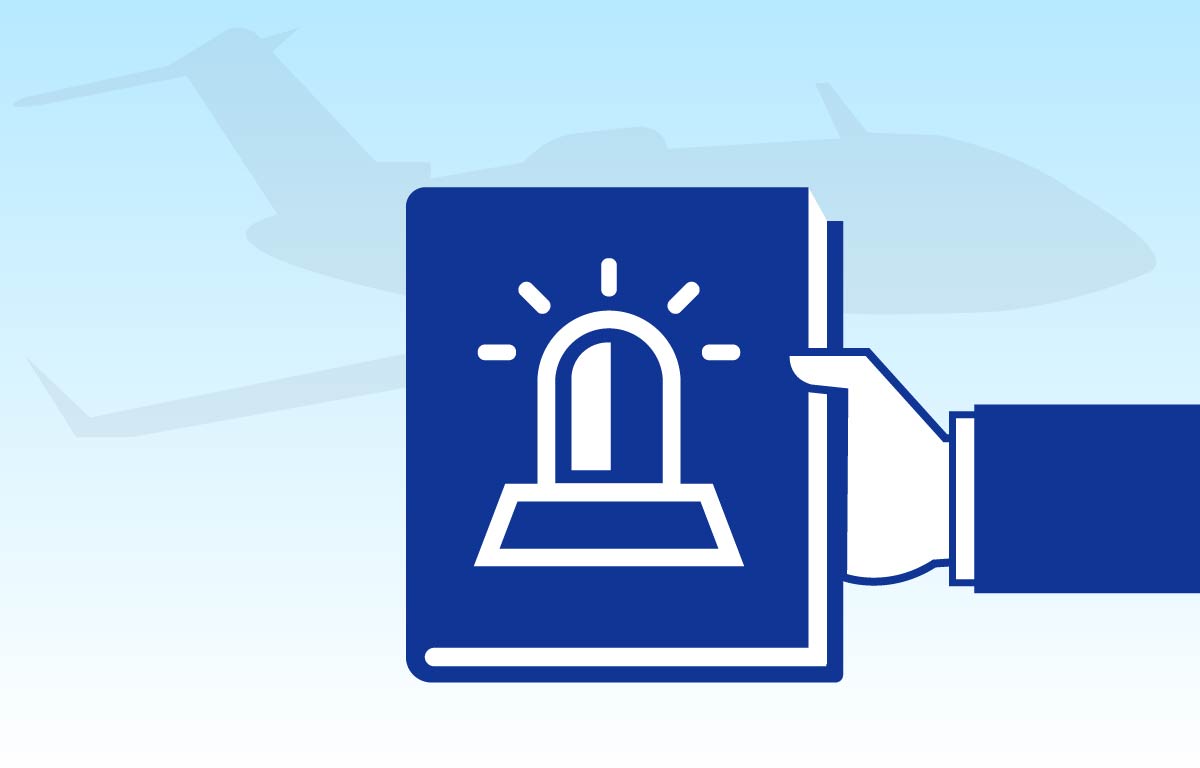It’s something you need but hope to never use: an aviation Emergency Response Plan (ERP). For any flight department, drone operator, or FBO, this is your “go-to” when an incident, accident, or emergency occurs. As you set up your ERP there are three things to keep in mind: basic structure, key elements of any emergency response, and the roles of your personnel when an emergency occurs.
Recommend structure.
- Initial reporting stage
Applicable to every incident, it guides users through the very first steps of responding to any emergency. - Checklists
Tailored to different types of incidents, such as an aircraft that’s gone missing, a hangar fire, or a medical emergency, the checklists provide the additional actions needed to respond to each unique situation. - Detailed policy and instructions
The heart of the program, it explains company policies, procedures for the management of the ERP, and details about expectations and actions when responding to various emergencies. Procedures to return to normal after the emergency response has concluded should also be included.
The content within each of the three areas above should be customized to your specific operation. It needs to take into account your size, resources available to you, types of operations, and areas of operations. For example, departments in Florida might have a section on hurricanes, whereas those in Alaska will cover blizzards.
Key elements of any emergency response.
- Regulatory responsibilities
- Crisis communications
- Notification of family and loved ones
- Coordination with external agencies
These include investigative authorities (e.g., NTSB, police, etc.), third-party vendors you are working with to coordinate the response effort, and corporate resources (e.g., HR, legal, communications, etc.).
Regulatory responsibilities
This means taking care of “the legal stuff”. It may be legally required to report information regarding the incident to the authorities. An ERP should include contact details for the relevant authorities. In the event of an emergency occurring in a foreign country, an ERP can be especially useful to point a person in the right direction, since they might be unfamiliar with specific regulations.
Once an investigation has started, it’s important to remain involved so that you can engage your SMS and learn from the incident to ensure mistakes aren’t repeated.
Crisis communications
This covers handling of communication such as with the media. Usually, one spokesperson is appointed to make sure there is a clear and consistent message. The importance of this has become particularly critical due to the prevalence of social media. With incidents now reported within seconds of occurring, operators must step up their game when it comes to social media monitoring and responsiveness. Companies should establish social media policies, such as not disclosing any investigation findings via their personal accounts – anything and everything can be picked up.
If your flight department is tied to a corporate entity, you should also work with your head office to ensure your communication procedures do not conflict with existing policies. You will need to identify which communications tasks the flight department is expected to perform, and which will be handled by the corporate office.
Notification of loved ones
Without question, this is the most critical item when handling an emergency or incident. This includes taking care of relatives and the loved ones of those directly involved in the accident, but also extends to providing colleagues and those indirectly involved in the accident with a place to go for information and support. In all instances, the company should be the most trusted information source.
With news spreading so quickly, it may be unavoidable that family members find out about an incident through a news source first. However, a company should strive to be the first to reach loved ones, even if it means managing unknowns.
If you plan to utilize a third-party resource to perform emergency contact notification and/or support, it is vital to identify which tasks will be performed by the third party in your ERP.
Your role in an aviation ERP
Knowing the responsibilities of your role within a department will help in an emergency scenario.
- Schedulers and Dispatchers
Their roles are vital during the initial phase. Keeping the crew and passenger manifest up-to-date and verifying flight routes might provide early recognition of whether an aircraft has been involved in any reported incidents. - Flight Department Administrators
They take care of the day-to-day operations. Their role would be to manage media and family inquiries, and should be trained how to handle sensitive situations. In cases of major or fatal aviation accidents, using an external crisis management firm is advised. - Flight Department Managers
They typically have the central role in an emergency ensuring the proper execution of the aviation ERP. Aside from monitoring adherence to regulatory responsibilities, they also ensure everyone in the department is coping and provide resources for counseling. - Maintenance Department
The maintenance department will most likely need to gather information such as aircraft maintenance data, logs, and records. Maintenance personnel are also a valuable resource for maintenance-specific subject matter expertise. - Pilots
They are frequently the on-scene responders. Apart from their normal pilot training, they should be trained in first-aid, emergency signals and managing in-flight issues. Pilots are also a valuable resource for operational-specific subject matter expertise. - Safety Officers
They play a unique role after an incident or accident. They are key to ensuring the flight department learns from and takes steps to mitigate against events reoccurring. They gather information from an investigation and engage their SMS to provide analysis, mitigation strategies / corrective actions, and reports.
It’s time to set up your aviation ERP
Although many flight departments may have considered aviation accidents such as a crash, many don’t always consider other incidents, such as a hangar fire, an on-board medical emergency, or even an incident where the full nature of the emergency is unknown. Additionally, smaller companies that do not have the support of corporate resources, may need to develop additional procedures to help them manage and stay on top of potential incidents.
This is why it’s important to have a unique ERP, customized to an organization.
AviationManuals can help you develop your aviation ERP to suit the needs of your organization – big or small. If you’re looking for a bigger safety management plan, be sure to check out ARC Safety Management.
Feel free to call us with any questions – we’re always ready to help.



